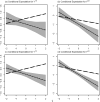A joint modeling and estimation method for multivariate longitudinal data with mixed types of responses to analyze physical activity data generated by accelerometers
- PMID: 28786180
- PMCID: PMC5656438
- DOI: 10.1002/sim.7401
A joint modeling and estimation method for multivariate longitudinal data with mixed types of responses to analyze physical activity data generated by accelerometers
Abstract
A mixed effect model is proposed to jointly analyze multivariate longitudinal data with continuous, proportion, count, and binary responses. The association of the variables is modeled through the correlation of random effects. We use a quasi-likelihood type approximation for nonlinear variables and transform the proposed model into a multivariate linear mixed model framework for estimation and inference. Via an extension to the EM approach, an efficient algorithm is developed to fit the model. The method is applied to physical activity data, which uses a wearable accelerometer device to measure daily movement and energy expenditure information. Our approach is also evaluated by a simulation study.
Keywords: accelerometers; longitudinal data; mixed effects model; multivariate longitudinal data; penalized quasi-likelihood.
Copyright © 2017 John Wiley & Sons, Ltd.
Figures



Similar articles
-
Three-part joint modeling methods for complex functional data mixed with zero-and-one-inflated proportions and zero-inflated continuous outcomes with skewness.Stat Med. 2018 Feb 20;37(4):611-626. doi: 10.1002/sim.7534. Epub 2017 Oct 19. Stat Med. 2018. PMID: 29052239 Free PMC article.
-
Hierarchical functional data with mixed continuous and binary measurements.Biometrics. 2014 Dec;70(4):802-11. doi: 10.1111/biom.12211. Epub 2014 Aug 18. Biometrics. 2014. PMID: 25134936
-
Multivariate t nonlinear mixed-effects models for multi-outcome longitudinal data with missing values.Stat Med. 2014 Jul 30;33(17):3029-46. doi: 10.1002/sim.6144. Epub 2014 Mar 17. Stat Med. 2014. PMID: 24634345
-
Variable selection for joint models of multivariate longitudinal measurements and event time data.Stat Med. 2017 Oct 30;36(24):3820-3829. doi: 10.1002/sim.7391. Epub 2017 Jul 14. Stat Med. 2017. PMID: 28707701
-
Model selection techniques for the covariance matrix for incomplete longitudinal data.Stat Med. 1995 Jul 15;14(13):1397-416. doi: 10.1002/sim.4780141302. Stat Med. 1995. PMID: 7481180 Review.
Cited by
-
Learning about Our Vices from Devices: A Model of Individual Learning with an Application to Consumer Food Waste.J Agric Resour Econ. 2023 May;48(2):296-308. doi: 10.22004/ag.econ.320676. J Agric Resour Econ. 2023. PMID: 37333048 Free PMC article.
-
Bayesian analysis of multivariate mixed longitudinal ordinal and continuous data.Aust N Z J Stat. 2024 Sep;66(3):325-346. doi: 10.1111/anzs.12421. Epub 2024 Aug 13. Aust N Z J Stat. 2024. PMID: 39720482 Free PMC article.
-
Joint modelling of multivariate longitudinal clinical laboratory safety outcomes, concomitant medication and clinical adverse events: application to artemisinin-based treatment during pregnancy clinical trial.BMC Med Res Methodol. 2021 Oct 9;21(1):208. doi: 10.1186/s12874-021-01412-9. BMC Med Res Methodol. 2021. PMID: 34627141 Free PMC article. Clinical Trial.
-
Joint modelling of longitudinal data: a scoping review of methodology and applications for non-time to event data.BMC Med Res Methodol. 2025 Feb 17;25(1):40. doi: 10.1186/s12874-025-02485-6. BMC Med Res Methodol. 2025. PMID: 39962370 Free PMC article.
-
A Review of Statistical Analyses on Physical Activity Data Collected from Accelerometers.Stat Biosci. 2019;11(2):465-476. doi: 10.1007/s12561-019-09250-6. Epub 2019 Jun 28. Stat Biosci. 2019. PMID: 32863980 Free PMC article.
References
-
- Kozey-Keadle S, Libertine A, Lyden K, Staudenmayer J, Freedson PS. Changes in sedentary time and spontaneous physical activity in response to an exercise training and/or lifestyle intervention. Journal of Physical Activity and Health. 2014;11:1324–1333. - PubMed
-
- Fieuws S, Verbeke G. Pairwise fitting of mixed models for the joint modeling of multivariate longitudinal profiles. Biometrics. 2006;62:424–431. - PubMed
-
- Fieuws S, Verbeke G, Boen F, Delecluse C. High dimensional multivariate mixed models for binary questionnaire data. Journal of the Royal Statistical Society: Series C (Applied Statistics) 2006;55:449–460.
MeSH terms
Grants and funding
LinkOut - more resources
Full Text Sources
Other Literature Sources
